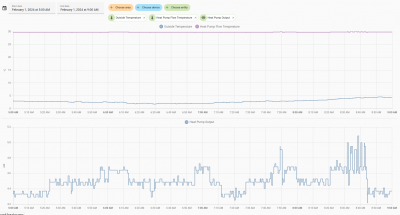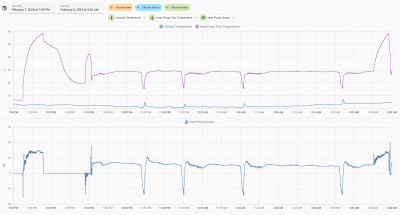Defrost Cycles - How Common Are They?
@rupes If you could add outside air temp to that chart that may help. In my experience, defrost cycle rate is a combination of outside air temp and humidity and flow temperature/heat demand.
Here is a period where my OAT was around 2 deg, with no defrost cycles. Heat pump is Samsung Gen6 16kW [flow temperature peaks is DHW runs]
Chart #1 - 4 hour period no defrost cycles
Chart #2 - Same heat pump, slightly cooler OAT, a couple of defrost cycles 11 hour period - defrost about once per 90 minutes
Chart #3 - Bit more difficult to get data out quickly further back, but here is some data showing about a 50 min gap between defrosts, this is when OAT was below zero.
Posted by: @mikefl@rupes This is very interesting. I'm trying to wire up my LLH heater atm, but it's a tricky cabling path for both power, and the control switch from the external unit. I want to just "try it" for a while to see the impact, before I see if it's worth the cost of adding a new circuit to my consumer unit.
From what you show, 15:00-19:30 ish is standard defrost (every 40 mins) and you aren't hitting target LWT; then after that the cycles extend to around 1 hour, and you are hitting LWT target. It's whether that improvement is worth the cost of the COP=1 power of the LLH heater.
Can you add external air temp to your graph? Maybe it was just warmer after 19:30? The key temp for a Grant seems to be 3C and lower.
Do you know how much power the LLH is drawing? It's a 3kW element, but the Grant docs suggest it'll only pull 250W in "defrost cycle help" mode. I'm a little sceptical.
I will add another version of that chart with outside temperature later in the week - I'm away from my home assistant server right now so can't access the data unfortunately. The temperature was mostly between 0 and 2deg during that day and did rise slightly into the evening but only to about 3deg and the unit was still defrosting fairly frequently into the night. I would agree with you that the issue is mainly confined to around 3deg outdoor temperature and below.
I'm also a bit sceptical about the 250W figure - for starters, presumably they mean 250Wh rather than 250W. It would also depend on how you set it up - you can define the flow temperature at which the immersion heater will switch off. I set mine at 40degC and looking at the data the defrost cycle results in flow temperature being below that level for about 12 minutes. I'm not sure at what point the immersion heater kicks in but 12 minutes out of every 37 minutes is about 1/3rd of the time so that would equate to about 1kWh of electricity consumption every hour - on a day like last Thursday that would have been quite an uplift on my total electricity consumption. I don't currently have any means to check exactly how much is being used by the immersion.
I did give some further thought to my idea of switching off the central heating circulation pumps during the defrost cycle. With the data I am collecting from the heat pump I have a sensor for "Defrost Temperature". It appears that just before the Defros cycle begins the defrost temperature drops to about -7deg. At the moment the defrost cycle starts the compressor switches off and the heat pump power consumption drops to 100W and stays there for 3 minutes before the defrost process begins. So using the combination of the defrost temperature being below -6deg and the power consumption going to 100W I can trigger an automation which switches my three underfloor heatings zones off for 10 minutes. This immediately switches off the underfloor heating pump an means that the colder water is not being pumped around my underfloor heating circuits. The heating demand remains on from the other zones so the heat pump will go into recovery mode as soon as the defrost is finished. This should provide two benefits - 1. the heated floors are not being actively cooled during the defrost - the water in the UFH pipes should stay warm and continue dissipating heat into the floor. 2. The remaining zones should be able to heat up more quickly as there is a smaller body of water to be heated by the heat pump during it's recovery from the defrost and by the time the UFH switches back on the heat pump is more or less back up to temperature. That's my theory anyway - but I'm probably displaying a complete lack of understanding of the laws of thermodynamics. Now I just need some more cold weather to test it out properly - I did have it running overnight and the trigger was working correctly but I didn't quite have my signals to the ufh heating zones working correctly. I also may need to fine tune the 10 minutes upwards a bit.
Grant Aerona3 13kW
@rupes Thanks for the info. I've seen a defrost temp of -3 and -4 trigger the cycle. It's definitely the 100W consumption figure which shows we're in defrost (or the HP has made the decision to defrost).
Grant Aerona 3 10kW
- 26 Forums
- 2,396 Topics
- 54.3 K Posts
- 369 Online
- 6,077 Members
Join Us!
Worth Watching
Latest Posts
-
RE: Recommended home battery inverters + regulatory matters - help requested
To me that makes sense. Bond the inverter neutral to t...
By JamesPa , 4 minutes ago
-

RE: Power outages and storms: A surprisingly good DNO experience
To be fair, the interactions I’ve been having recently ...
By Majordennisbloodnok , 27 minutes ago
-

RE: Setback savings - fact or fiction?
As far as I am aware, the majority, if not all, of the ...
By cathodeRay , 2 hours ago
-
RE: Advice for a novice on Mitsubishi Ecodan 6kW
Fair point. The highest frequency of defrosts I'd seen...
By Sheriff Fatman , 13 hours ago
-

RE: Heatpunk Floor plan issues
It's usually the complete opposite... seldom that Safar...
By Mars , 13 hours ago
-
RE: RDSAP10 effect on existing heat pump EPC rating?
@mike-patrick interesting update - thanks.I've been thr...
By Tim441 , 14 hours ago
-

RE: Fan is clipping ice build up from the front of unit.
@majordennisbloodnok I’ll not go there thanks! Toodles.
By Toodles , 16 hours ago
-

RE: Running from backup generaor in powercut?
@majordennisbloodnok Back in the 80’ or 90’ we had a te...
By Toodles , 16 hours ago
-
RE: Running my new Nibe ASHP efficiently
I'm new to the forum. Did you get a reply to this last ...
By Mike @ Camelot , 17 hours ago
-

RE: ASHP Energy Consumption: Aira 12kW heat pump
@grantmethestrength MCS requirements for DHW capacity h...
By Toodles , 18 hours ago
-
RE: New Mitsubishi Ecodan 11.2kW installation - L9 errors and maybe more
Great to hear! I just figured this out a day or tw...
By anotherdaveuk , 19 hours ago
-
RE: Help me keep the faith with my air source heat pump installation
@adamk I'm observing my own system at low temperatures ...
By dr_dongle , 1 day ago
-

RE: Free Ecoheat Heat Pump Install
@deltona Yes older houses are problematic like that, bu...
By bontwoody , 2 days ago
-
RE: Radiator sizing sanity check
As I mentioned early on the cost of supplying and fitti...
By JamesPa , 2 days ago
-
RE: Electricity price predictions
Great point, one of the key ones in my chat with Octopu...
By Batpred , 2 days ago
-

RE: New Fogstar 15.5kWh upright solution
Let me point out that there are many Chinese suppliers ...
By Transparent , 3 days ago
-

RE: Weather compensation- why you should use it
@majordennisbloodnok — The Two Ronnies Mastermind sketc...
By cathodeRay , 3 days ago
-
Just realised that this image of the cylinder cupboard ...
By Sheriff Fatman , 3 days ago
-

RE: Rodents! A word of warning for heat pump owners
Two thoughts: 1: Let's ask @david-s if Primary Pro in...
By Transparent , 3 days ago








